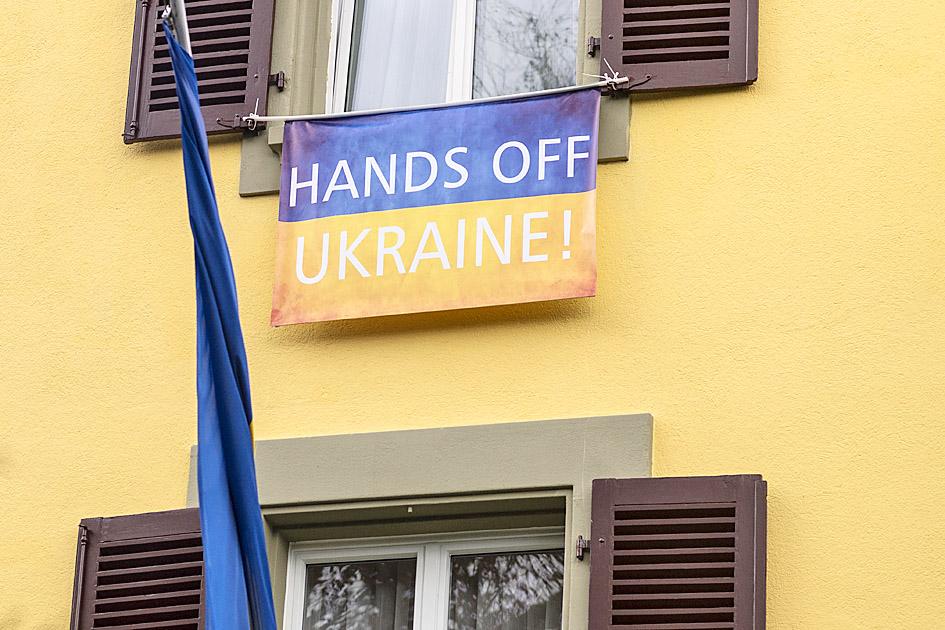With the smell of war in the air over Europe, world leaders got over the shock of Russian President Vladimir Putin’s order to deploy troops to separatist regions of eastern Ukraine and are focused on producing as forceful a reaction as possible.
Germany made the first big move, taking steps to halt the process of certifying the Nord Stream 2 gas pipeline from Russia.
The West insisted that Putin’s bold moves in Ukraine contravened countless international agreements and since words of diplomacy had failed, it was time to move toward action.

Photo: AP
“No lows too low, no lies too blatant, no red lines too red to cross,” Lithuanian Prime Minister Ingrida Simonyte said in summing up the political disgust felt from Europe to North America and democracies hugging Russia’s borders in Asia, such as Japan and South Korea.
Russia said that it is sending what it deems “peacekeepers” into eastern Ukraine, but EU High Representative for Foreign Affairs and Security Policy Josep Borrell said that they were “troops” on sovereign Ukrainian territory.
“I wouldn’t say that’s a fully fledged invasion, but Russian troops are on Ukrainian soil,” Borrell said.
The EU’s foreign ministers were to decide later yesterday on how deep a first batch of sanctions would have to cut.
It would likely stop far short of the “massive” package threatened by the EU and Washington for a full military invasion into national territory that Kyiv still controls.
“The way we respond will define us for the generations to come,” Simonyte said.
However, too much, too soon could also hurt the international response, Austrian Chancellor Karl Nehammer said.
A conflict could devastate Ukraine and cause huge economic damage across Europe, which is heavily dependent on Russian energy, but Asian nations are also worried.
South Korean President Moon Jae-in instructed his officials to prepare for the economic fallout if the Ukraine crisis worsens and US-backed nations levy stringent economic sanctions on Russia.
New Zealand Minister of Foreign Affairs Nanaia Mahuta said there was no basis under international law for Putin to recognize the Ukrainian separatist regions.
“We are concerned that this is a calculated act by President Putin to create a pretext for invasion, which would be a clear act of aggression. We again call for urgent diplomatic efforts to find a peaceful resolution,” Mahuta said in a statement.
Those on a saddle between Russia and the West were in an uncomfortable position.
NATO-member Turkey, which has close relations with Ukraine and Russia, criticized Moscow’s decision to recognize the independence of the regions in eastern Ukraine.
“We consider this decision by Russia as being unacceptable,” Turkish President Recep Tayyip Erdogan said. “We reiterate our calls to the parties to respect common sense and international law.”
Washington could be much more straightforward. The White House issued an executive order to restrict investment and trade in the separatist regions, and additional measures — likely sanctions — were to be announced later yesterday.
Those sanctions are independent of what Washington has prepared in the event of a Russian invasion, according to a senior administration official who briefed reporters on the condition of anonymity.

TRAGEDY STRIKES TAIPEI: The suspect died after falling off a building after he threw smoke grenades into Taipei Main Station and went on a killing spree in Zhongshan A 27-year-old suspect allegedly threw smoke grenades in Taipei Main Station and then proceeded to Zhongshan MRT Station in a random killing spree that resulted in the death of the suspect and two other civilians, and seven injured, including one in critical condition, as of press time last night. The suspect, identified as a man surnamed Chang Wen (張文), allegedly began the attack at Taipei Main Station, the Taipei Fire Department said, adding that it received a report at 5:24pm that smoke grenades had been thrown in the station. One man in his 50s was rushed to hospital after a cardiac arrest

SAFETY FIRST: Double the number of police were deployed at the Taipei Marathon, while other cities released plans to bolster public event safety Authorities across Taiwan have stepped up security measures ahead of Christmas and New Year events, following a knife and smoke bomb attack in Taipei on Friday that left four people dead and 11 injured. In a bid to prevent potential copycat incidents, police deployments have been expanded for large gatherings, transport hubs, and other crowded public spaces, according to official statements from police and city authorities. Taipei Mayor Chiang Wan-an (蔣萬安) said the city has “comprehensively raised security readiness” in crowded areas, increased police deployments with armed officers, and intensified patrols during weekends and nighttime hours. For large-scale events, security checkpoints and explosives

A car bomb killed a senior Russian general in southern Moscow yesterday morning, the latest high-profile army figure to be blown up in a blast that came just hours after Russian and Ukrainian delegates held separate talks in Miami on a plan to end the war. Kyiv has not commented on the incident, but Russian investigators said they were probing whether the blast was “linked” to “Ukrainian special forces.” The attack was similar to other assassinations of generals and pro-war figures that have either been claimed, or are widely believed to have been orchestrated, by Ukraine. Russian Lieutenant General Fanil Sarvarov, 56, head

PUBLIC SAFETY: The premier said that security would be tightened in transport hubs, while President Lai commended the public for their bravery The government is to deploy more police, including rapid response units, in crowded public areas to ensure a swift response to any threats, President William Lai (賴清德) said yesterday after a knife attack killed three people and injured 11 in Taipei the previous day. Lai made the remarks following a briefing by the National Police Agency on the progress of the investigation, saying that the attack underscored the importance of cooperation in public security between the central and local governments. The attack unfolded in the early evening on Friday around Taipei Main Station’s M7 exit and later near the Taipei MRT’s Zhongshan